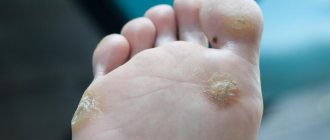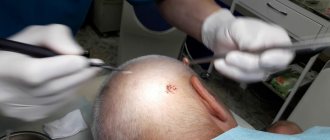Any malignant tumor is the result of mutations that have occurred in cells. Some of these mutations disrupt DNA repair mechanisms or disable important proteins that prevent malignant degeneration, while others make the cell “immortal” and force it to multiply uncontrollably.
Today, tests are available that help identify genetic changes in tumor cells. All of these mutations are relatively easy to detect after the fact, but their causes can often only be guessed at. Damage to genes can be caused by certain chemicals (they are called carcinogens), physical factors (radiation, X-rays, ultraviolet radiation, burns), infections, and chronic inflammatory processes. After all, a DNA error can happen by accident.
One of the causes of malignant degeneration of cells is viruses. The most famous pathogens that can lead to such fatal consequences are human papillomaviruses, abbreviated as HPV. They are sexually transmitted and can lead to cervical cancer, as well as a number of other cancers.
What kind of virus is it and where does it come from?
The human papillomavirus (HPV) lives in the blood, appears on the skin and mucous membranes and is transmitted from these areas by contact - by touch, i.e. it is not an infection transmitted exclusively through sexual contact. Moreover, the human papillomavirus can live in the body for a long time, even from birth, and appear for the first time in the middle of life due to a decrease in immunity.
You cannot associate the first manifestation of the virus with a recent infection - it could have happened a long time ago, although you did not know it.
According to official statistics, the prevalence of HPV is quite high - up to 70%, although doctors in their practice encounter it in 90% of cases. Fortunately, not all types of the virus are oncogenic.
An integrated approach to combating cervical cancer
The Global Strategy to Accelerate the Elimination of Cervical Cancer as a Public Health Problem, adopted by the World Health Assembly in 2022, recommends a comprehensive approach to the prevention and control of cervical cancer. The recommended set of measures includes activities covering the entire life cycle.
A life-cycle approach to cervical cancer control
| Primary prevention | Secondary prevention | Tertiary prevention |
Girls 9–14 years old
| Starting from age 30 among women in the general population and from age 25 among women with HIV infection | All women as needed |
| If necessary, vaccination is offered to both girls and boys | Treatment of invasive cancer at any age | |
· Encouraging the use of condoms and making them available to those having sexual relations
|
|
|
Prevention of cervical cancer should be carried out on the basis of an interdisciplinary approach and include components such as public awareness, social mobilization, vaccination, screening, treatment and palliative care.
Prices for services
Initial appointment with a gynecologist + ultrasound (assessment of complaints, medical history, examination in a gynecological chair, pelvic ultrasound, consultation)
Primary appointment – visiting a doctor of a specific specialty for the first time. Make an appointment
1680 ₽ 2400 ₽
Repeated appointment with the gynecologist
With the exception of repeated appointments with doctors: Blatsios N.D., Dzhashiashvili M.D. Make an appointment
1200 ₽
Ultrasound of the pelvis in women (uterine cavity, ovaries)
Make an appointment
1500 ₽
Screening and treatment of precancerous lesions of the cervix
Screening
Cervical cancer screening involves testing for HPV infection to identify precancerous lesions, followed by appropriate treatment. Testing is carried out among women who have no symptoms and feel completely healthy. If screening detects HPV infection or precancerous lesions, they can be easily treated and thus prevent the development of cancer. Screening can also detect cancer at an early stage, when there is a high chance of cure.
WHO's updated guidance now recommends that countries use HPV tests for cervical screening, including:
- HPV DNA tests, which detect highly dangerous strains of HPV that cause almost all types of cervical cancer;
- HPV mRNA tests to detect HPV infections that lead to the appearance of atypical cells.
HPV tests, unlike visual examinations, provide an objective result. They have proven to be easy to use, detect more precancerous and cancerous conditions, and save more lives. Their use is also more economically justified compared to visual examination methods or cytology (Pap smear).
In the general population of women, screening should be performed using a validated HPV test starting at age 30 at intervals of 5 to 10 years; Among women with HIV infection, it should be carried out starting at 25 years of age. In addition, HIV-infected women should be screened more frequently, every 3–5 years.
To perform cytology and HPV testing, medical personnel use similar procedures for collecting a cervical sample. WHO allows patient self-sampling when testing for HPV DNA (but not mRNA). Women must be given adequate support to complete this procedure with confidence.
Screening should be linked to the treatment and management of patients with positive screening results. HIV-positive women in resource-poor settings may be prescribed treatment without confirmatory diagnosis. However, treatment for HIV-positive women can begin only after receiving a positive test result for HPV (for example, visual examination using acetic acid).
Treatment of precancerous conditions
If it is necessary to treat precancerous lesions and the patient meets the treatment criteria, it is recommended to remove the affected tissue using cryotherapy or thermal ablation. Both treatments are effective and safe and can be performed on an outpatient basis.
If the criteria for ablative treatment are not met or if cervical cancer is suspected, the patient should be referred to a specialized medical facility that has the capabilities to conduct proper examination using colposcopy and biopsy. If necessary, she may undergo excision (LLETZ), and in the case of cancer, an individualized treatment plan can be developed taking into account the stage of the disease, the patient's health status and preferences, as well as the availability of medical resources.
How does HPV manifest?
- genital condylomas are multiple papillary formations on the mucous membranes of the genital organs. Many people do not pay attention to them, since these irregularities have existed since childhood, and people consider this their anatomical norm. In fact, the genital mucosa should be absolutely smooth;
- papillomas (warts) on the skin. Viral papillomas can disappear and appear on their own, as this is a manifestation of a viral infection;
- confluent genital warts. They have the appearance of cauliflower due to the fusion of genital warts into a single whole; they can be distinguished from other skin formations using a special apparatus (colposcope) using a vinegar test.
What does HPV look like: signs and symptoms
The majority of the population associates papillomas with formations on the skin that have an unaesthetic appearance, cling to clothing and cause psychological discomfort. These papillomas are represented by strains 1-5.
They are located in large numbers on the neck, under the arms, on the stomach, back and face, especially on the eyelids. These papillomas can be pedunculated, localized singly or form groups resembling the shape of cauliflower inflorescences, flat, similar to moles.
Despite their harmlessness (they cannot mutate into cancer cells), skin papillomas also need to be removed. They tend to grow and spread further. In addition, they have a very unaesthetic appearance, especially if they are located on the face. With age, immunity declines, and in older people, in addition to age spots, a scattering of warts and other formations can be seen on the skin.
Papillomas occur even in young children. This is due to the fact that the virus is easily transmitted from mother to child during childbirth and through everyday contact, for example, breastfeeding or sleeping with parents.
In children, papillomas are never oncogenic. Basically, they look like warts that have a keratinized, rough surface and are located on the knees, elbows, and palms. Flat papillomas in infants cause itching and inflammation. Plantar papillomas look like calluses and tend to rub against shoes.
Drop-shaped papillomas are located under the arms, in the neck, on the face, and chest. When injured, they bleed or grow even larger. Located on the mucous surface of the larynx and nose, papillomas cause difficulty breathing and cause anxiety to the baby.
At an early age, papillomas are not removed, because in 80% of cases they go away on their own. Rashes are provoked by frequent acute respiratory viral infections, reduced immunity of the child, and inflammatory processes in the body.
If you notice warts on your child’s skin, you should definitely consult a doctor so that he can monitor them and take the necessary tests. In 30% of cases, warty dysplasia develops into oncology if the child is very weakened by other diseases.
In adolescence, juvenile papillomas are observed, similar in appearance to a nettle burn. The reason for their appearance is a hormonal explosion caused by sudden changes characteristic of puberty. They do not require treatment because they go away on their own, but they are a sign that the virus has settled in the body.
Seborrheic keratosis, which resembles carcinoma in appearance, is typical for older people. Neoplasms in old age require observation by a doctor, because only a specialist is able to distinguish a benign formation from skin cancer.
Genital warts are represented mainly by 6 and 11 strains that have low oncogenicity. But outwardly they have the repulsive appearance of dome-shaped growths with a rough surface. Unlike strains 1-5, this type of HPV is transmitted sexually or through contact of mucous surfaces.
Genital warts are localized in the perineal area. In women they are located on the vulva, vagina, in men - on the head of the penis.
And finally, the most dangerous manifestation of HPV:
- flat condyloma of the cervix. If all other forms are a manifestation of an acute process or an exacerbation of a chronic one, then flat condyloma is a manifestation of a long-term process that has caused a change in the epithelial cells of the cervix. Flat condyloma of the cervix can eventually lead to cervical cancer. But even in the presence of cell changes, condyloma flata is a viral disease and can be amenable to conservative antiviral treatment.
Can an HPV infection be cured?
There are currently no treatments that specifically target HPV. Papillomas and condylomas, as well as precancerous changes caused by HPV, can be removed surgically, using a laser, or cryosurgery. When the cervix is affected, loop electrosurgical excision (removal of a pathological formation using a wire loop heated by an electric current) and conization (removal of a cone-shaped section of cervical tissue) are used. However, it is important to understand that surgery cannot remove the virus from the body.
What is the main danger of HPV?
As mentioned above, the human papillomavirus plays an important role in the development of cervical cancer. By existing for a long time in the cells of the cervix, viruses lead to mutations, which in turn are the basis for the appearance of a cancer cell.
Cervical cancer is the most common malignant tumor of the female genital area after breast cancer. The average age of its development is 37-47 years, recently there has been a shift in age to an earlier age. Unfortunately, the tumor is often discovered in late stages due to women’s irregular visits to the gynecologist and frivolous reluctance to be examined for this pathology. Often, the prevention of this pathology comes down to “cauterizing” simple “erosion” in early reproductive age - without further examinations. Meanwhile, diagnosing changes in the malignant direction is quite simple and does not require any special procedures.
Make an appointment
Prevention measures
Although there are no treatments targeting HPV, there are effective prevention methods. It can be primary and secondary.
Primary prevention aims to prevent HPV infection. The most effective method is vaccination. In Russia, two vaccines against HPV types 16 and 18 are currently registered: Gardasil and Cervarix. They contain virus-like particles that do not cause infection, but trigger an immune response so that the body becomes protected when it encounters the real virus. In accordance with current international recommendations, all boys and girls aged 11–12 years should be vaccinated against HPV (you can start at 9 years old). To create reliable immunity, two doses of the vaccine must be administered. If a teenager has not been vaccinated before age 15, he will need three doses. Unfortunately, the vaccine will not be effective if a person is already infected. Therefore, people over 26 years of age who are sexually active can, of course, be vaccinated, but the benefits of vaccination for them are questionable.
In 2022, scientists proved that HPV vaccines prevent not only precancerous changes in the cervix, but also invasive cancer.
Other measures for primary prevention of malignant tumors caused by HPV:
- Sex education, taking into account the age of children and the cultural characteristics of society.
- Using condoms. Doctors should tell the public that this method of contraception helps protect against dangerous infections, including reducing the risk of HPV infection.
- To give up smoking. In this regard, it is also important for doctors and scientists to conduct educational work.
- Male circumcision. Penile cancer often develops in the foreskin area, so this is an effective preventative measure. So-called female circumcision is unacceptable even under the pretext of protecting against infections - in any form it is clearly a mutilating operation that deprives a woman of the opportunity to have a full sex life.
Secondary prevention aims to prevent the development of cancer in people who are already infected with high-risk HPV. All women who are sexually active (including those who have been vaccinated) should be regularly screened for cervical cancer:
- Up to 65 years - PAP test (Pap smear) every 3 years or PAP test in combination with HPV tests every 5 years. At least once a year it is necessary to undergo preventive examinations with a gynecologist.
- Over 65 years: If a woman has been screened regularly for the past 10 years and has not had any cancer or precancerous lesions (CIN 2 intraepithelial neoplasia or more severe) in the past 25 years, screening can be stopped.
- If a woman has had her uterus and cervix removed (not due to cancer or severe precancerous lesions), screening may not be necessary. If the uterus was removed, but its cervix was left, screening must be done like everyone else.
Research also shows that people at higher risk (who have anal sex, those with HIV) may also benefit from anal Pap smears. A malignant tumor or precancerous changes in the oral cavity or oropharynx can be detected by a dentist - this is another reason to undergo regular preventive examinations.
Screening helps to detect cancer at an early stage and begin treatment in a timely manner, thereby significantly improving the prognosis.
Of course, it is important to pay attention to any suspicious symptoms and not delay visiting a doctor. For example, cervical cancer can manifest itself in the form of abnormal vaginal bleeding (between periods, during sex, postmenopause), pain in the pelvis, and pain during sexual intercourse. These symptoms do not necessarily indicate that a woman has a malignant tumor; most often they indicate other diseases. But only a doctor after an examination can establish an accurate diagnosis.
In the clinics of the federal network "Euroonco" you can get a consultation with an oncologist-gynecologist, learn about your risks, and about screening tests that are recommended in your case. Our doctors have extensive experience in the treatment of benign neoplasms and malignant tumors of the female reproductive organs. We also have a comprehensive program “Women’s Health” - it includes all the necessary laboratory and instrumental tests, helps to identify many diseases in the early stages.
Book a consultation 24 hours a day
+7+7+78
How to detect malignant changes?
It is not difficult to detect changes in the cervix, but they are not visible to the naked eye. During a routine examination, the cervix may look completely unchanged, therefore colposcopy (examination of the cervix through a microscope) with a vinegar test and a test with Lugol's solution is a necessary part of the initial examination of women, as well as a cytological smear from the cervix. These studies must be repeated once a year (some authors consider it necessary to visit a gynecologist every six months), especially after self-healed erosions, after treatment with medicinal tampons and treatment with liquid nitrogen, regardless of the presence or absence of complaints. It is in these cases that cell degeneration can occur, especially when a viral infection is attached. So the presence of HPV itself is a sufficient risk factor.
Another necessary diagnostic method, as with any viral infection, is the PCR method. This method detects different types of HPV. It has been shown that different types have different oncogenicity, that is, they lead to the development of cervical cancer with different probability. Based on this, high-oncogenic and low-oncogenic were identified. However, it is in the diagnosis of human papillomavirus, unlike the diagnosis of other infections, that PCR diagnostics should not be decisive. As you know, analyzes are also sometimes erroneous. The basis for treatment is primarily the patient’s complaints. And if the clinical manifestations of sexually transmitted diseases are often nonspecific, and PCR diagnostics are carried out precisely to help the doctor identify the exact pathogen and select therapy not at random, but taking into account the sensitivity of this pathogen to specific drugs, then the clinical manifestations of the papilloma virus are obvious and specific, and in case of doubt, the final diagnosis can be made by histological examination. The PCR method is simply not needed in this case. And here's why: if you have condylomas, it's the human papillomavirus. If they are not there, then even if HPV is present in the body (and is detected by PCR), it still does not require treatment. Viruses live in the body for years, integrate into cells, change their genotype and cannot be treated
. Their external manifestations may change and be treatable, but not the presence of the virus in the body. Therefore, if at the time of examination there are no clinical signs of the papilloma virus, PCR diagnostics is not needed, because there is nothing to treat. In cases where there is suspicion of the presence of HPV in the body (if the PCR is positive or the papillomas were previously present or the partner has), observation, repeat colposcopy and cytology are indicated, and, if indicated, histology.
Human papillomavirus (HPV)
Table of contents
- How is the virus transmitted and how does it manifest?
- Why is HPV infection dangerous?
- Symptoms of HPV in women
- Treatment of different types of HPV in women
- Is it possible to prevent infection?
- Advantages of contacting MEDSI
Human papillomavirus (HPV) today is the most common infection
that affects residents of numerous countries.
The disease affects the mucous membranes and skin. Moreover, the virus can exist in human blood for a long time without detecting itself. Symptoms of HPV in women (as well as in men) appear when immunity decreases.
How is the virus transmitted and how does it manifest?
The disease is transmitted in the following ways:
- Sexual. Genital, oral-genital and anal
- Contact-domestic (by touching, using certain objects, etc.)
- During childbirth (child from mother)
A person infected with the virus suffers primarily from aesthetic problems. Unsightly growths form on his skin and can grow. Moreover, after removal the risk of relapse is very high.
Why is HPV infection dangerous?
Today, cervical cancer (CC) still ranks second in the world among female cancer pathologies, with more than 270 thousand women dying from this serious disease every year.
However, the disease can be prevented. It has been convincingly proven that one of the conditions for the development of cervical cancer is the presence of the human papilloma virus. Today, about 150 types of this virus are known and about 34 of them are associated with lesions of the anogenital area. Types 16, 18, 31, 33 and 39 are highly oncogenic. They can trigger the development of cancer of the cervix, vagina, penis and anus.
Symptoms of HPV in women
The disease in women usually manifests itself by the appearance of the following neoplasms on the skin and mucous membranes:
External signs of pathology are often absent for a long time, so the patient does not suspect that she is at risk
- Genital warts.
Such formations are among the most dangerous and appear mainly in the genital area. Condylomas are characterized by a flesh-colored or pale pink color and the shape of the papilla. Over time, such formations can degenerate into malignant tumors. - Flat warts.
Such neoplasms are benign and relatively safe. They do not cause cancer, but are contagious and are transmitted from person to person even by simple contact. Typically, flat warts grow on the face, legs and hands, are round in shape and small in size (up to 5 mm) - Bowenoid papulosis.
These formations appear on the genitals and in the perineal area, are quite dense, have a yellow or pink tint and the shape of plaques that rise slightly above the skin and mucous membranes
Also, human papillomavirus in women can manifest itself in the form of dysplasia. The epithelial cells of the cervix are affected by pathology. When HPV is present, they begin to change rapidly, causing a precancerous condition. With early diagnosis, the patient can be cured! In advanced cases, cancer occurs.
Important! External signs of pathology are often absent for a long time, so the patient does not even suspect that she is at risk!
Treatment of different types of HPV in women
Important! Widely advertised immunostimulants are ineffective in treating the virus. They have not passed the necessary tests and are not included in the protocols.
There are currently no effective treatments for the virus. You can only eliminate those pathological conditions that are provoked by HPV: remove papillomas and other formations on the skin and mucous membranes, treat dysplasia and cancer.
Today, neoplasms are successfully removed using radioknife, laser, cryocoagulation, etc. The procedure is carried out quite quickly and does not cause significant discomfort to the patient. After removal there are no large scars left. Surgical excision may also be performed.
The method of removing formations is selected individually. In this case, the doctor focuses on the patient’s characteristics, the size and location of the papilloma or other growth, as well as concomitant pathologies and existing indications and contraindications.
In MEDSI clinics, tumor removal is carried out using techniques such as:
- Electrocoagulation.
The formation is destroyed due to the effect of high-frequency current on it. A small wound usually heals quickly without leaving a scar. - Laser exposure.
This procedure allows you to quickly “burn out” the formation without leaving any traces. The intervention takes a couple of minutes and is suitable for removing warts and papillomas on open areas of the body (including the face) - Cryodestruction.
This technique involves exposing the formation to cooled nitrogen. Warts and papillomas are destroyed by very low temperatures and are independently rejected by the body - Radiosurgery.
To carry out the procedure, a modern instrument is used - a radio knife. It is capable of heating tissue in a non-contact mode and ensuring the evaporation of pathological cells. Radiosurgery, like laser surgery, is used to remove growths on open areas of the body - Chemical destruction.
During such interventions, acids and other drugs are used. They locally affect formations, violating their integrity - Surgical excision.
This technique is relevant for large or deeply sprouted formations. Due to the fact that the surgeon works manually, he can quickly remove the formation and send pieces of tissue for examination (to determine whether they are benign or malignant)
Important! If a woman has no complaints and no papillomas or dangerous changes are detected as a result of exposure to the papilloma virus on the body, treatment is not carried out! In this case, the patient should undergo regular examinations (PAP test and colposcopy).
Is it possible to prevent infection?
Yes! The high incidence rate has provoked the interest of scientists in the development of not only therapeutic, but also preventive measures. A real breakthrough was the creation and introduction of vaccines into world practice.
HPV vaccination in women and men: what is it and what vaccines are there?
Vaccination is a preventive measure! It protects against infection and helps prevent the risks of health and life-threatening consequences of the virus.
Today, 2 drugs are registered in Russia - Gardasil and Cervarix! Both vaccines are effective and safe. They have undergone extensive clinical trials and have proven almost 100% effective in preventing diseases associated with HPV (including cervical cancer pathologies).
A real breakthrough was the creation and introduction of vaccines into world practice.
However, it is better to use Gardasil. This is due to the fact that such a vaccine acts against 4 types of virus. It protects against cervical cancer, vulvar, vaginal, anal cancer, anogenital condylomas, cervical, anal, vulvar and vaginal intraepithelial neoplasia and adenocarcinoma in situ.
"Gardasil" can be used:
- Girls and women from 9 to 45 years old
- Boys and men from 9 to 26 years old
Vaccination involves the administration of 3 doses of the drug and is carried out according to the schedule: 0‑2‑6 months.
It can be prescribed even to previously unvaccinated people who have been diagnosed with the virus. This is due to the fact that the patient may not be infected with all types of HPV!
Important! Vaccination does not replace the need for screening tests and regular examinations by a gynecologist.
Today, Gardasil is included in the compulsory vaccination schedule in many European countries and the USA. Some countries have already proven effective reductions in morbidity rates.
Important data on reducing the incidence of cervical cancer among those vaccinated were obtained in Australia, where, from 2007 to 2016, 78% of 15-year-old girls and 72% of boys of the same age were vaccinated in this way. As a result, the prevalence of HPV among women 18–24 years of age decreased from 22.7% to 1.1% from 2005 to 2015, and the incidence of precancerous cervical lesions in the population of girls under 18 years of age decreased by 38%.
Advantages of contacting MEDSI
- Experienced specialists.
Our doctors are always ready to provide comprehensive medical support to all categories of patients. They will not only advise you, but will also carry out diagnosis, treatment (including the consequences of HPV in women) and prevention of various pathologies, if necessary. - Opportunities for effective diagnosis of HPV.
In our laboratory, you can take tests to detect the presence of oncogenic HPV serotypes (categories) in the body. This examination is especially relevant when immunizing patients over 25 years of age. - Possibilities for removing tumors.
We use classic and modern technologies. This allows you to choose the appropriate option for each patient. - Timely vaccination.
The drug for vaccination is always available. By contacting us, you will not be forced to delay vaccination. It is possible on the day of application - Using a modern, highly effective drug.
The safety and effectiveness of Gardasil have been confirmed by international clinical trials, which were conducted with the participation of a large number of study subjects.
Our doctors are always ready to provide comprehensive medical support to all categories of patients.
If you are planning to visit our clinic for the purpose of vaccination against HPV, examination for this virus, or treatment of precancerous conditions and cancer, call (495) 7-800-500. Our specialist will answer all questions and make an appointment for you at a convenient time.
How to treat and how to live with it?
In the absence of manifestations of HPV, the carrier is still contagious and transmits the virus to others. So there is no point in worrying about this - most young people are infected with HPV. It's not scary. Let us repeat: the virus is dangerous only when it manifests itself on the cervix or glans penis. There it has oncogenic activity and requires treatment. In other cases, this is more a cosmetic problem than a medical one. If there are clinical manifestations of the virus, PCR is especially not necessary; the general algorithm for managing patients with papilloma virus is included: colposcopy, biopsy, treatment. The criterion for choosing treatment is the severity of dysplasia (i.e., changes in cells on the cervix), and not the type of virus. Severe dysplasia and a low-oncogenic type of virus require treatment. The highly oncogenic type and the absence of dysplasia do not require surgical treatment.
HPV poses an oncogenic danger only to the cervix and glans penis. Papillomatosis of the skin, vagina, and external genitalia is not dangerous from an oncological point of view, and its treatment depends on the severity of the cosmetic defect, the patient’s desire and the severity of itching, a frequent companion of the papilloma virus. It should be remembered that surgical removal is not a treatment for papillomatosis, but only the removal of altered tissue. The virus will remain in the blood, with a decrease in immunity, genital warts will form again, and the person will continue to infect others. This does not mean that there is no need to remove condylomas; it means that when they reappear, you should not think that you were poorly treated or were re-infected. This is your virus, and you have to live your life with it. There is nothing scary about this, you just need to lead a healthy lifestyle, maintain your immune system and monitor places that are dangerous from an oncological point of view (the cervix or the head of the penis).
Other articles by the author
- Endometrial polyp
- Bacterial vaginosis
- Adenomyosis of the uterus
- Painful periods
- Human papillomavirus and cervical cancer
- Vulvitis
- Vulvovaginitis
- Hormonal disorders
- Cytomegalovirus
- Endometritis
- Endometriosis
- Cervical erosion
- Chlamydia
- Trichomoniasis in women
- Hidden infections
- Female infertility
- Adnexitis, inflammation of the appendages
- Urinary incontinence in women
- Bartholin gland cyst
How is HPV treated?
Currently, there is no 100% cure for HPV. The only way to protect against the virus is vaccination, carried out at the age of 9-12 years. The Cervarix and Gardasil vaccinations protect against sexually transmitted strains 6 and 11.
The drug is administered intramuscularly three times, and during this time the body produces antibodies to the virus. Despite the high price, vaccination will significantly reduce the risk of developing the cervix in girls whose family members have had cases of cancer of the reproductive organs.
The main method of treating papillomas is complex, combining surgical removal of skin tumors and enhancing immunity. The most effective and painless method for the patient is the radio wave method. It is performed under local anesthesia. The tumor is removed by a high-frequency radio wave, cutting off exclusively the area affected by papilloma.
Self-removal of papillomas at home is not recommended, despite the sale of various products such as celandine in pharmacies. This is delicate work that cannot be done independently. As a result, skin burns and rapid relapse.
HPV treatment in St. Petersburg
At the Diana clinic, the doctor will prescribe the necessary tests and identify the exact cause of the relapse. Perhaps HPV manifested itself due to hidden hormonal disorders or the development of another disease that the patient was not previously aware of.
When treating papillomavirus in our clinic, you will receive specialist advice on further strengthening your immune system. This will help prevent dangerous complications from HPV.
The specialist will give an accurate answer whether the patient is at risk of malignant neoplasms. For this reason, you should definitely undergo an examination and consult a doctor, even if papillomas do not cause any concern.
ONLINE REGISTRATION at the DIANA clinic
You can sign up by calling the toll-free phone number 8-800-707-15-60 or filling out the contact form. In this case, we will contact you ourselves.
Why do papillomas appear?
There is only one reason for papillomas on the cervix – the entry of a virus into the body. But there are several ways through which he can penetrate. We list them in order of increasing likelihood of infection:
- Sexual contact with an HPV carrier. At the same time, the use of condoms, according to experts, is not able to protect against infection.
- Everyday route: when visiting public institutions (baths, swimming pools, etc.), through the use of hygiene items shared with the carrier.
- A child can become infected during childbirth if the mother has an acute form of the disease.
The immune system of a healthy person is so strong that it is able to overcome the papilloma virus. If immune cells control the virus, external forms of the disease do not develop immediately after infection. However, when the defenses are weakened (severe stress, fatigue, excessive alcohol consumption, smoking), the virus can become more active and cause the formation of papillomas, as well as associated pathologies.
Facts about papillomas
Here are some key points about skin papillomas:
- Skin papillomas are benign tumors of the skin unless they are exposed to friction and sun exposure.
- They usually occur in folds of the skin or areas subject to constant friction.
- They are not dangerous and can be removed for aesthetic and cosmetic reasons.
- The list of methods for removing skin papillomas includes laser therapy, radiofrequency therapy, cryotherapy, and excision with a scalpel.
How is HPV treated in women?
Combination therapy includes removal of formations and the use of various systemic nonspecific antiviral and immunomodulatory drugs. Doctors at the clinic consider preventive vaccination against HPV to be an effective method of preventing infection (especially if carried out before sexual contact of any kind) and it perfectly complements the main treatment regimen.
1. Local therapy
Aimed at eliminating the formations themselves and atypically changed epithelium. The most popular are cryodestruction, thermocoagulation, chemical coagulation, laser destruction, and removal of condylomas using radiosurgery. Most often, these methods eliminate the manifestations of HPV on the labia minora and single and multiple formations in the anus (in women and men). Each has a number of advantages and disadvantages. So, local treatment of papilloma virus is:
a) elimination of genital warts using one of the above methods. b) local impact on visible growths (ointments, suppositories). c) in the intralesional administration of drugs with antiviral activity.
2. General therapy
The second part of the therapeutic measures is to reduce the concentration of the human papillomavirus in the woman’s body. Its amount is directly related to the state of the body’s immunity - the better it is, the less virus there is. Therefore, the most promising way is to strengthen the immune system. The HPV treatment regimen includes the following:
a) elimination of concomitant infections; b) restoration of normal microflora of the vagina/intestines; c) correction/stimulation of immunity, HPV vaccination.
All these measures together make it possible to reduce the viral load in the body and prevent the emergence and progression of new formations.
3. Traditional medicine
Experiments on treating HPV at home are quite common. However, activities of this kind can be very dangerous: the results of the use of traditional medicine, various magical rituals and self-medication in general most often result in injuries, burns, rapid spread of condylomas to other areas and malignant degeneration of formations.
home
HPV Clinic
The World Health Organization (WHO) has developed recommendations on how to prevent and control HPV-induced genital cancer in women through vaccination and screening. In May 2022, WHO named the three main measures for the prevention of cervical cancer: vaccination against HPV, medical screening and timely treatment of background and precancerous cervical diseases.
Which doctor should I contact? In Moscow, for all questions related to HPV in women, you can contact our clinic on Kutuzovsky Prospekt. For you a complete list of necessary services, expert specialists for women and teenage girls. The doctor selects an HPV treatment regimen individually for each patient, based on diagnostic results and general health. Our gynecologists do not miss important symptoms of HPV infection during examination - condylomas and papillomas, which, unfortunately, often happens in other clinics. We have the technical capabilities for this. Do you want to make sure and see the finds for yourself? Please, we will show it on the monitor screen (read more in the material “Video colposcopy”).
Prices for HPV treatment
Basic range of clinic services for women:
✘ Appointment with a doctor with examination for HPV - 2500 ₽; ✘ HPV treatment (price for prescription regimen) - 3000 ₽; ✘ Consultation with a teenage doctor - 2500 ₽; ✘ High-risk HPV types - from 650 ₽; ✘ Analysis for the number of HPV oncotypes - 950 ₽; ✘ Colposcopy/vulvoscopy - 1500 0 ₽; ✘ Digen test (HPV DNA set) - 6200 ₽; ✘ Panavir dropper (with placement) - 5500 ₽; ✘ Allokin Alpha injection (with injection) - 3500 ₽; ✘ Taking a smear for human papillomaviruses - 450 rubles.
Given the widespread prevalence of the disease, doctors treating HPV recommend that both women, girls and adolescents contact and be tested for their presence.
WHO activities
The World Health Assembly adopted a global strategy to accelerate the elimination of cervical cancer as a public health problem. Cervical cancer elimination was defined as achieving a threshold of fewer than 4 cases of cervical cancer per 100,000 women per year. To achieve this threshold by the end of the 21st century, WHO has set 90–70–90 targets to be reached by 2030 and sustained thereafter (WHA73.2) (4):
- 90% of girls should be fully vaccinated against HPV by age 15;
- 70% of women should be screened with a high performance test at age 35 and again at age 45; And
- 90% of women with diagnosed cervical disease should receive treatment (provide treatment for 90% of women with precancer; provide treatment for 90% of women with invasive cancer).
WHO has developed guidelines and tools for the prevention and control of cervical cancer through vaccination, screening and treatment, and therapy for invasive cancer. WHO works with countries and partners to develop and implement comprehensive programs in line with the global strategy.











